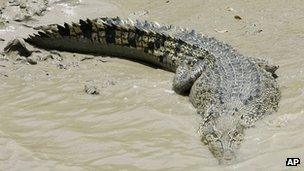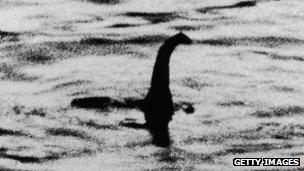Monsters Inc: Scottish lochs and their creatures
- Published

A mermaid-like creature is said to haunt Loch Morar
Loch Ness is known all over the world for its legendary monster, Nessie. But it is far from the only creature said to inhabit Scotland's lochs. Could you place the locations of Lizzie or the slug pig?
Morag, a lesser-known cousin of the Loch Ness Monster, was in the spotlight last week.
Researchers had found accounts at the University of Edinburgh library of the mysterious creature from the 1900s.
The historic papers revealed local descriptions of Morag as a mermaid-like creature and a beastly death omen.
But Morag is just one of several loch monster stories hidden in the long shadow cast by Nessie.
Just south of Loch Ness is the much smaller Loch Oich, where a beast with a shaggy, dog-like head is said to have been seen.
A little further down the Great Glen from Loch Oich is long and straight Loch Lochy.
The flat area of land separating Oich and Lochy is known to historians as the site of Blar na Léine - the Battle of the Shirts.
Fought on 15 July 1544, it marked a violent escalation in a dispute over the leadership of Clanranald, one of the most powerful branches of Clan Donald.
But, for monster hunters, Loch Lochy is better known as the haunt of Lizzie. First reported as being sighted in 1929, Lizzie is said to have three humps and resemble a plesiosaur, a description sometimes used for Nessie.
Like Nessie, no sighting of Lizzie has ever been confirmed and plesiosaurs were long-necked marine reptiles that became extinct at the same time as the dinosaurs - but the legends refuse to die.
There are also tales that Loch Quioch, which like Lochy and Oich is in Lochaber, has a plesiosaur-like beast. Quioch's monster has also been described as a water horse, or kelpie, a serpent with a horse's head.

A large crocodile is said to have been seen in Loch Lomond
According to an entry in the Clan Cameron Archives, external, Loch Arkaig, west of the Great Glen, has a "lake-horse" that in the past was seen by a deer stalker and his children.
Another Lochaber water feature with a supposed monster is Loch Sheil. Glenfinnan at the head of the loch is where Bonnie Prince Charlie raised his standard in August 1745.
In the loch's waters, a creature 21.3m (70ft) long and with three humps was said to have been spotted in 1870.
It is claimed Muc-Sheilche haunts Loch Maree in Wester Ross. The Gaelic name may mean "slug pig".
And the monsters are not exclusive to Highland fresh water lochs.
Apparently, Loch Lomond has a beast reported to resemble a plesiosaur but has also been described as looking like a large crocodile.
'Giant sterile eels'
The mysterious depths of Scotland's lochs attract many curious visitors.
Richard Freeman, of Devonshire-based Centre for Fortean Zoology, has visited both lochs Ness and Morar.
He said he was told of two Yorkshiremen encountering something strange in Loch Morar in recent years.
The pair were on a fishing holiday and had been out on the loch in a boat when they saw what they thought was a tree trunk heading towards them at speed. Moments before a collision, the object arched up and dived down into the water.
Once they got themselves back on the land, the two men hastily packed their belongs and left for home.

Plesiosaurs, such as Elasmosaurus, died out with the dinosaurs
Mr Freeman believes the monster sightings can be explained.
He said: "The idea of a pre-historic reptile in these cold northern lakes is a non-starter.
"However, the monsters could be some kind of large fish. I think the best bet are giant sterile eels.
"The common eel swims out to the Sargasso Sea to breed then die. The baby eels follow scent trails back to their ancestral fresh waters homes and the cycle begins again.
"Sometimes, however, a mutation occurs and the eel is sterile. These stay in fresh water and keep on growing. Known as eunuch eels, no-one knows how old they get or how big."
Mr Freeman said two Canadian tourists came across a 7.6m (25ft) eel floating in shallow water of Loch Ness in February 2004.

Nessie is Scotland's best known monster legend
"At first, they thought it was dead, but when it began to move, they beat a hasty retreat," he said.
Loren Coleman, of the International Cryptozoology Museum in Portland, Maine, in the US - where exhibits include information on the Loch Ness Monster - said Scotland was rich in stories and sightings of unusual creatures.
He said: "Scotland has reports of loch monsters, black panthers and mammals that should not be there such as wild boars, bears and other species."
But Nessie is likely to continue to reign supreme as Scotland's top monster.
During the Edinburgh International Science Festival, a one-day conference called Nessie 80, will be held on the 6 April.
Speakers will include Dr Charles Paxton, a member of the Centre for Fortean Zoology, and naturalist Adrian Shine of the Loch Ness Project.
The event will celebrate the first report of a modern sighting of the Loch Ness Monster, which was made in 1933 and reported in the Inverness Courier.
- Published25 February 2013
- Published1 February 2013
- Published11 October 2012